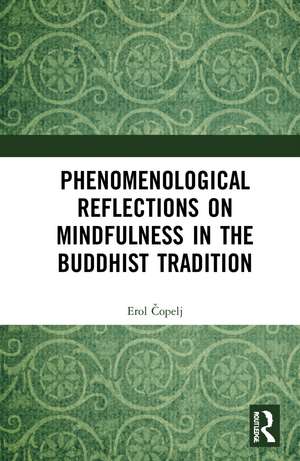Phenomenological Reflections on Mindfulness in the Buddhist Tradition
Autor Erol Čopeljen Limba Engleză Paperback – 29 ian 2024
Beginning with descriptions of how mindfulness is encountered in everyday, pre-philosophical life, the book moves on to an analysis of how the Pali Nikāyas of Theravada Buddhism define mindfulness and the practice of cultivating it. It then offers a critique of the contemporary attempts to explain mindfulness as a kind of attention. The author argues that mindfulness is not attention, nor can it be understood as a mere modification of the attentive process. Rather, becoming mindful involves a radical shift in perspective. According to the author’s account, being mindful is the feeling of being tuned-in to the open horizon, which is contrasted with Edmund Husserl’s transcendental horizon. The book also elucidates the difference between the practice of cultivating mindfulness with the practice of the phenomenological epoché, which reveals new possibilities for the practice of phenomenology itself.
Phenomenological Reflections on Mindfulness in the Buddhist Tradition will appeal to scholars and advanced students interested in phenomenology, Buddhist philosophy, and comparative philosophy.
| Toate formatele și edițiile | Preț | Express |
|---|---|---|
| Paperback (1) | 389.66 lei 6-8 săpt. | |
| Taylor & Francis – 29 ian 2024 | 389.66 lei 6-8 săpt. | |
| Hardback (1) | 1000.27 lei 6-8 săpt. | |
| Taylor & Francis – 24 iun 2022 | 1000.27 lei 6-8 săpt. |
Preț: 389.66 lei
Nou
Puncte Express: 584
Preț estimativ în valută:
74.56€ • 81.25$ • 62.83£
74.56€ • 81.25$ • 62.83£
Carte tipărită la comandă
Livrare economică 23 aprilie-07 mai
Preluare comenzi: 021 569.72.76
Specificații
ISBN-13: 9781032112497
ISBN-10: 1032112492
Pagini: 300
Ilustrații: 10 Line drawings, black and white; 10 Illustrations, black and white
Dimensiuni: 152 x 229 x 16 mm
Greutate: 0.4 kg
Ediția:1
Editura: Taylor & Francis
Colecția Routledge
Locul publicării:Oxford, United Kingdom
ISBN-10: 1032112492
Pagini: 300
Ilustrații: 10 Line drawings, black and white; 10 Illustrations, black and white
Dimensiuni: 152 x 229 x 16 mm
Greutate: 0.4 kg
Ediția:1
Editura: Taylor & Francis
Colecția Routledge
Locul publicării:Oxford, United Kingdom
Public țintă
Postgraduate and Undergraduate AdvancedCuprins
Introduction
Part I
1. Mindfulness in Literature and Everyday Life
2. The Definition of Mindfulness in the Pāli Nikāyas
3. Mindfulness in the Contemporary Literature, a Critical Analysis
Part II
4. Mindfulness in the Husserlian Context
5. Radicalising the Reduction
6. A Phenomenology of Mindfulness, and Related Phenomena
7. Mindfulness in Action
Conclusion
Part I
1. Mindfulness in Literature and Everyday Life
2. The Definition of Mindfulness in the Pāli Nikāyas
3. Mindfulness in the Contemporary Literature, a Critical Analysis
Part II
4. Mindfulness in the Husserlian Context
5. Radicalising the Reduction
6. A Phenomenology of Mindfulness, and Related Phenomena
7. Mindfulness in Action
Conclusion
Recenzii
"A unique book exploring Husserlian methodology that intersects with Indian Buddhist thought by tuning-in through a close textual analysis of Satipaṭṭhāna (foundation of mindfulness). Lively everyday examples and clear explanations are a treat for both novices and experts alike."
Jay Goulding, York University, Canada
"This is a good introduction to an important topic mindfulness in Indian Buddhism in terms of a phenomenological interpretation."
Wing-Cheuk Chan, Brock University, Canada
Jay Goulding, York University, Canada
"This is a good introduction to an important topic mindfulness in Indian Buddhism in terms of a phenomenological interpretation."
Wing-Cheuk Chan, Brock University, Canada
Notă biografică
Erol Čopelj received his Ph.D. in Philosophy from Monash University, Australia and Warwick University, UK. His published work has appeared in Husserl Studies, Phenomenology and the Cognitive Sciences, and The Routledge Handbook of Phenomenology and Phenomenological Philosophy (2020).
Descriere
This book offers an original phenomenological description of mindfulness and related phenomena, such as concentration (samadhi) and the practice of insight (vipassanā). It demonstrates that phenomenological method has the power to reanimate ancient Buddhist texts, giving new life to the phenomena at which those texts point.
